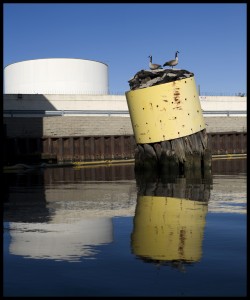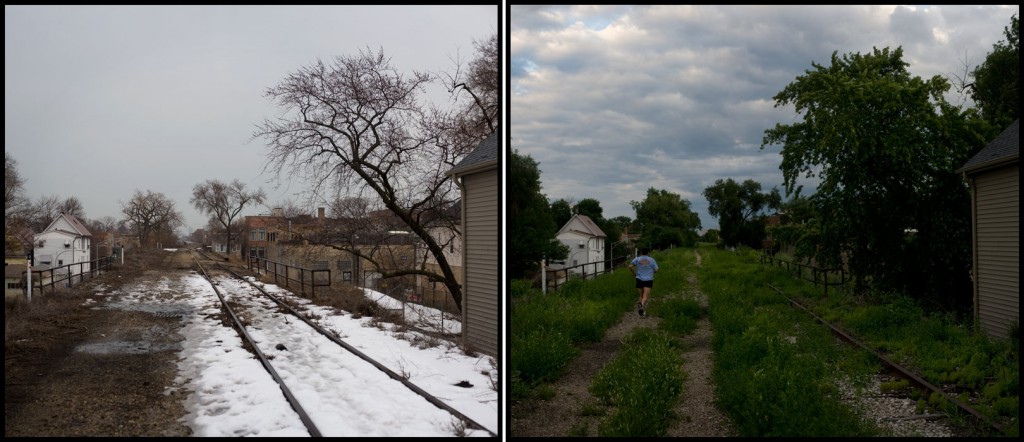Nature within the urban landscape is simultaneously close at hand and hidden from view — a paradox of proximal obscurity. Yet its myriad forms and manifestations are as diverse in kind as their human denizens. City parks, community gardens, nature centers, green rooftops, restoration sites, golf courses, back yards, alleys, vacant lots, landscaped public spaces, plus the resident non-human biota in all its riotous diversity and plenitude — all these and more comprise urban nature.

Despite the ubiquity and fascinating heterogeneity of urban nature, it remains largely invisible to and thus unappreciated by many city dwellers. We are much more likely to assume nature exists “out there,” away from our cities and suburbs — especially in remote depopulated places characterized by the well worn but still compelling aesthetics of the beautiful or the sublime. Our culture assumes that city, country, and wilderness are distinct landscape types with clear regional boundaries, and an implicit corollary to that is that the city is unnatural. The fact that urban green spaces are often compromised and degraded by pollution, development, or overuse only underscores that point. Yet the recent coinage of the seemingly oxymoronic phrase “urban wilderness” signals that ecologists, artists, environmental advocates, and citizens have begun to re-envision the role of nature within metropolitan landscapes.
Just about any American city could serve as a fruitful setting for analyzing the character and significance of urban nature; indeed, such analyses are best done with the specificity of a particular locale in mind. Consider, then, Chicago. The Windy City’s natural and cultural histories are not only long-studied and well-documented, but also inextricably linked with how we’ve thought about, confronted, transformed, abused, and (of late) restored the natural environment of urban areas. From its beginnings as a marshy trading post on the banks of the Chicago River, to its amazing expansion as an industrial power during the 19th and 20th centuries, to its profound reshaping of the physical landscape in that process, to its ascension as a global city in the 21st century that strives to be environmentally progressive — Chicago is an ideal laboratory in which to study the diverse manifestations of nature in urban spaces.

This nature is almost always hybrid in character, a product of human action (whether deliberate or not) even when appearing “natural” in outward form. Chicago, the self-proclaimed City in a Garden, has spent the better part of its brief existence unapologetically bending nature to its will, from the audacious engineering feat of raising the grade level of its streets and buildings in the mid-19th century in order to install a proper sewer system, to the subsequent development of lakefront parklands atop countless tons of landfill, to the famous reversal of the Chicago River’s current.
This interconnection of the made and the natural can be read in the landscape . . . if one observes carefully and knows where to look. Such is the ongoing quest of photographer and urban explorer Ryan Hodgson-Rigsbee, who investigates and documents the Chicago cityscape on foot, by bicycle, and aboard a kayak. Hodgson-Rigsbee’s growing body of photographs are a stunning visual echo of the urban nature writings of Leonard Dubkin (1905-1972), a journalist and self-taught naturalist who chronicled his explorations of and observations about Chicago’s urban landscape in the middle decades of the twentieth century, and who found a surprising biotic diversity within otherwise unremarkable settings such as vacant lots, railroad buffer zones, or residential yards. Even more importantly, Dubkin advocated the need for human connection to the wildlife — and patchwork of wild lands — that remained close at hand, within the city’s borders, an implicit theme of some of Hodgson-Rigsbee’s landscapes.
The splendid diversity of nature in Chicago can be categorized in many ways, one of which consists of a simple binary: official and unofficial. The former includes the green spaces purposefully designed and designated for human use (parklands of all kinds) as well as the conservation of natural resources (forest preserves, wetland conservation sites, prairie restoration areas). These areas comprise the official version of Chicago’s urban nature — the sort that is featured on the city’s website and which collectively is an incredibly important and irreplaceable resource for the interaction of people with the natural world. The “unofficial countryside” of Chicago, though — to use a phrase from the English naturalist-writer Richard Mabey — is the hardscrabble, unexpected, and often uncared-for everything else. It is this which drew the eye of Dubkin in the last century, and which is now framed by the camera of Hodgson-Rigsbee.
One such place, little known yet vast and in plain view, is sometimes referred to as The Brownlands. A sprawling 100-plus acre tract of empty land a mile or so south of the soaring skyscrapers of Chicago’s Loop and just north of the bustling Chinatown neighborhood, the Brownlands are readily visible to hundreds of commuters each day as they make their way into the city on the Rock Island Line commuter train.

Incredibly, part of this land was once water. The South Branch of the Chicago River wound its way through the area, bending eastward toward Lake Michigan before meandering back west and resuming its southerly course. This D-shaped curve of the river’s channel proved inconvenient for shipping and an impediment to street transportation improvements; so the river here was straightened and channelized in the late 1920s, a water infrastructure project of great scale, expense, legal complexity, and civic ballyhoo, for the reordered urban landscape was supposed to usher in an era of unprecedented economic development for this industrialized area of the city.
These plans never quite materialized, for the through streets on this “reclaimed” land were never completed. The Brownlands thus remain mostly vacant and part of Chicago’s unofficial countryside. Long owned by a railroad well into the late twentieth century, the land was sold to speculative developers in the late 1990s and has changed hands a few times since, though the goal of these recent landowners has not changed. They envision, predictably but unimaginatively, an ambitious riverfront development project of fashionable residences and upscale retail establishments. Fortunately, the mammoth expense of such a project has kept it in limbo, and the Brownlands persist in 2011 as a wide-open space of non-native brush and invasive weeds, patches of prairie grasses which hint at the land’s pre-settlement ecological legacy, informal pathways and abandoned gravel roads, discarded vehicles and miscellaneous machinery, and furtive human visitors who brave the fenced barriers and No Trespassing signs to explore, camp, photograph, bird, even live in the Brownlands.
An example of a contemporary frontier-like space in the middle of America’s third-largest city, the Brownlands simultaneously evoke the past technological transformation of Chicago’s landscape and the present human yearnings for off-the-grid experiences with an unmediated nature. They also hearken to an uncertain future in which yet another large-scale development project may dramatically alter what is now an open space in the shadow of Chicago’s Loop with remarkable restoration and recreation potential.
Another significant hybrid place where nature and the built environment converge is the Bloomingdale Trail, an abandoned elevated train line that runs for nearly three miles on the city’s near-North Side. A grassroots non-profit organization, Friends of the Bloomingdale Trail, is in the process of raising funds to convert the defunct railway into an elevated greenway/trail, citing the recently developed High Line linear park in Manhattan as model and inspiration. Currently the project enjoys the backing of some influential politicians (including the outgoing mayor, Richard M. Daley, a noted environmental progressive), but needs to raise upwards of $60 million to finance construction in hopes of completing the Trail by 2016.

Beyond the politics and economics of its development, this proposed parkland is notable for the ways in which it will perform multiple functions and tie together the built and natural landscapes with the city’s diverse human denizens in mind. Part greenway, part commuter route, part public art tableau, part recreational space, the Bloomingdale Trail illustrates how urban space can be re-imagined to embody sustainable transportation alternatives for everyone from children walking to their neighborhood schools to cyclists commuting from their homes to nearby elevated train stations on the CTA Blue Line. Besides these immediate practical benefits, though, the Trail exemplifies the many nature/culture hybrid spaces in Chicago that are in various stages of transition from an old “brown” urban infrastructure of steel and asphalt to a new “green” infrastructure of recreational trails, native plant communities, and ecology-minded landscapes. What is common to this and similar projects in Chicago and other cities is that they do not simply happen because they are good ideas; they require immense amounts of human and financial capital to conceptualize and bring to fruition, even when the political winds are favorable.
The Brownlands and the Bloomingdale Trail are but two examples of Chicago’s unofficial countryside that exists apart from the formally designated parklands, forest preserves, and other green spaces of the city. These and other hybrid spaces are amalgams of nature and culture, places that dramatize the earth’s vulnerability to human alteration even as they show us the resilience and adaptability of plant and animal life within the constraints imposed by brick, steel, and concrete. For the artist, they present a nearly inexhaustible subject for representing the complexities and paradoxes of nature in the city.
An excerpt from this essay was published as the introductory text to While Wandering: Chicago, a book a photographs by Ryan Hodgson-Rigsbee (Urban Nature Media, 2011).

4 thoughts on “The Character of Urban Nature”
Comments are closed.